The crows started it. I noticed that they often played in the puddle that formed in a rock garden next door when it rained. I like the crows; they’ve rewarded my frequent conversation attempts with keeping my roof moss and twig free, and when they’re feeling really social, they bring me dead things.
So I got a bird bath on sale at the grocery store garden centre and moved it in. It added a delightful pop of colour to my garden, but I didn’t often see birds enjoying it, which bummed me out. But they did seem to like the water spray from the sprinklers, so I figured I’d put in a fountain and spent $11 on a cheap solar pump from Amazon for the bird bath. Within hours, you’d have thought there was a Taylor Swift sighting. It wasn’t just the crows — all the local birds were dancing about, enjoying themselves in the fountain.
You can buy water features at your local garden centre or home store, and they proliferate Wayfair, Amazon, and the like. But they almost always are expensive and require electricity. I liked the idea of being able to stick a water feature wherever I wanted, free of cords, but I also just didn’t want to spend that much. So, I Amanda’d it.
How to DIY a simple solar fountain in your yard
Really, any bird bath or large bowl or planter can become a fountain. It doesn’t require much more than a vessel that can hold at least a gallon of water and gets some sun. There are inexpensive stand-up baths online, and I’m always surprised how many are being given away for free on platforms like Facebook Marketplace and Craigslist.
However, you acquire your basin, these simple and inexpensive floating pumps work spectacularly well, all for under $20. So long as there’s sun and enough water in the basin, they’ll pump water into 10 or so different configurations you can choose from. While I like a tall spray, I found the bath would dry out too quickly, so I tend to keep it on a low bubbler. I refill it every few mornings, and I bring the pump inside every winter.
You don’t have to use a tall birdbath, either. Any large tub would work, and the larger and more water it will hold, the better. You can also fill your tub with stones of any kind, which means that birds and bees will have something to land on, and safely drink while not drowning.
Most of the time, you can expect your fountain to only work in the sunshine, so it will stop at night. Some solar fountains have a higher battery capacity, so they can hold a charge and work out of the sunlight for a time. Some pumps have tasteful lights on them to work at night (and some have less tasteful lights).
How to construct a solar spillover fountain
By the end of pandemic year three, I had twelve bird feeders, mason bees, and a charming squirrel installation in my yard. I wanted a way for some of the landborne critters to get access to water during the hottest days, and loved the look of the spillover fountains I saw. I still didn’t want to pay for an expensive electric fountain, though, so I became determined to figure it out with solar.
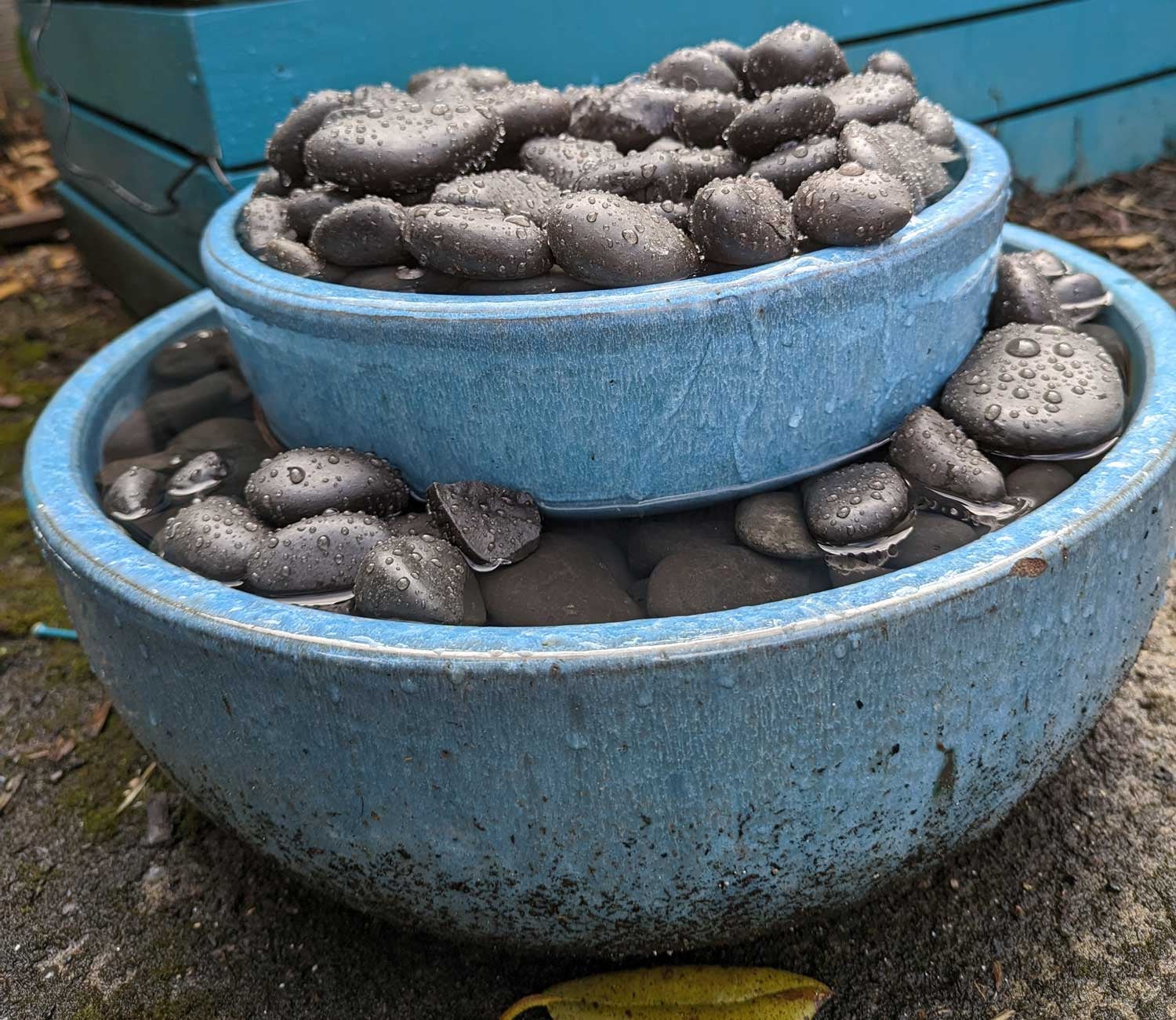
To start, you’re going to need a different pump, this time one with some tubing and the ability to push the water up that tubing. I started with two low planters I got on sale, with one about ⅔ of the size of the other. Ceramic are nice, but they make similar plastic or resin planters now that are surprisingly high-end looking and can be painted. It’s always worthwhile to get on your local garden centre’s email list for the pottery sales, and look for places nearby that offer discounted pottery.
Obviously, you’ll need to plug any drainage holes on the bottom planter, and I used waterproof clear silicone and some rocks to do so. I used a river rock a little larger then the hole, and added a lot of silicone to the bottom to seal it off. Leave the hole on the top bowl open.
Take your small terra cotta pot and break off a small piece of the rim with a hammer. Be careful: Terra cotta is easy to crumble, but you just need the pot to have enough integrity to stand up. You can also use a plastic pot, the kind you get your seedlings in — just drill a hole in the bottom of it large enough to accommodate the clear tubing of the pump.
Place the pond pump in the middle of the large basin, and use a little silicone to glue it down. (They often come with suction cups, but they’re not great at keeping them in place.) Drape the cord on the rim of the pot, and attach the clear tubing to the outlet of the pump. Run it up through the hole in the bottom of the overturned pot, and put the pot on top of the pump.
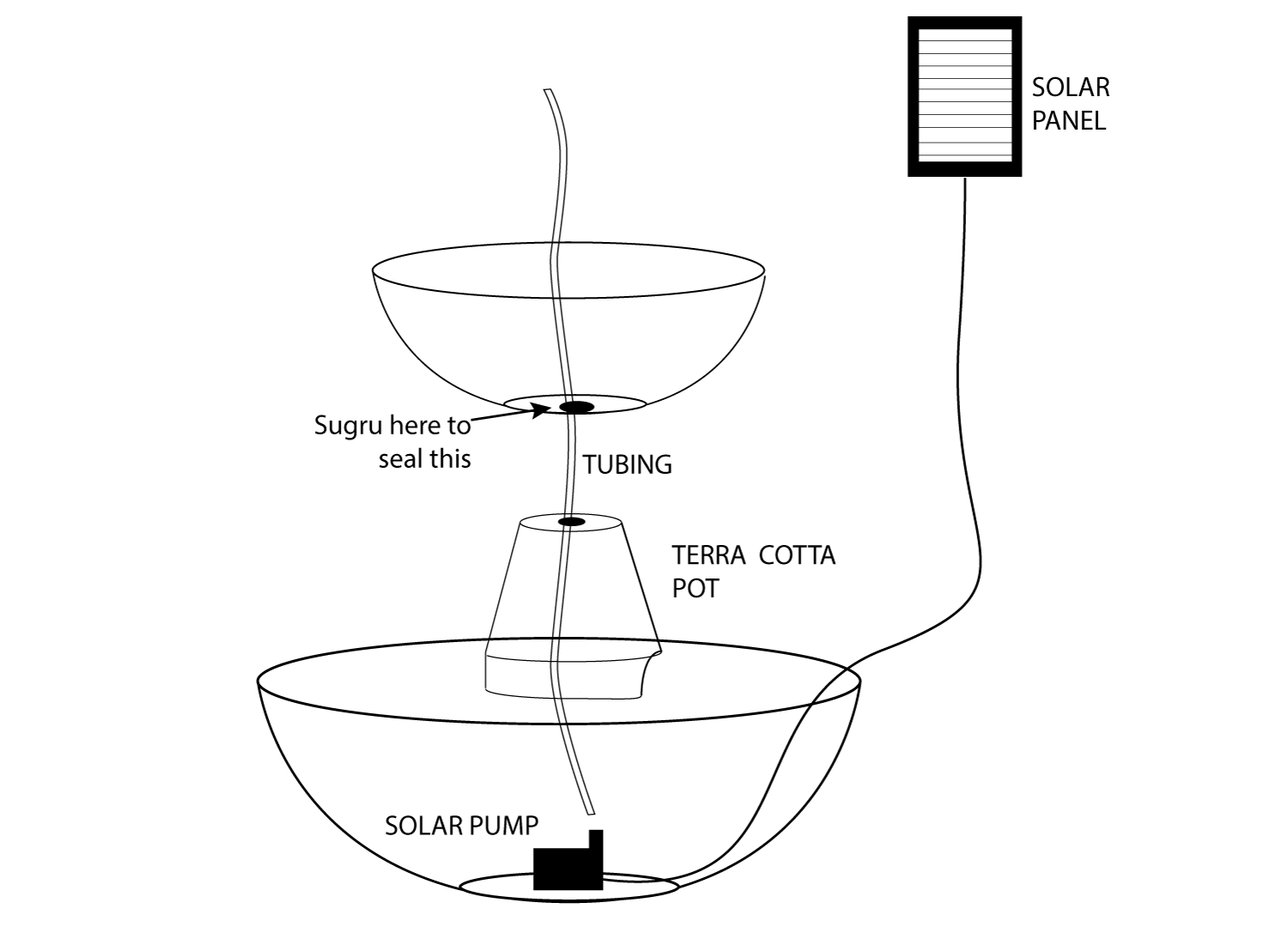
Fill the bottom planter with river rock, up to two inches below the rim. River rock has jumped in price recently, but I was able to score plenty of it for free on Craigslist. Now you’re going to add the smaller bowl by placing it on top of the pot, with the tube running up through the hole in the bottom of the bowl. Take out some Sugru, and massage it in your hands for a minute, then make a coil with it, and coil it around the tubing and seal up the hole. Sugru is moldable silicone and will make it watertight.
Leave everything to dry for twelve hours, then fill up the top bowl with river rock, all the way to the top of the bowl, keeping the silicone tubing in the middle, sticking straight up. Trim the tubing to the height of the rocks, so it disappears. Now push it sideways a little, so it’s at an angle.
Fill the bottom bowl with water just up to the top of the rocks, then fill the top bowl completely to the top, and put the solar panel in the light. You’ll see that the top bowl will start to spillover, recycling the water from the bottom. It doesn’t make a lot of noise, but it does provide a place for bees, squirrels, frogs, and birds to settle for a momentary drink.
How to construct a solar-powered bubbler fountain
These above ground installations were fun and all, but it was time to go bigger. I kept seeing rock bubblers and in short, I wanted one. I needed the bubbles, man. I’m also cheap, and there was no way I could afford $500-2,000 for one. I knew I could DIY it with parts, I just didn’t know if I was going to be able to get enough power from a solar pump to get the height you needed for a bubbler.
That height, or lift, is part of the specs for every pump out there. I needed a few feet. I was thrilled to discover there are solar pumps that will give you that many gallons per hour (GPH) and height, but they, too, were expensive.
Rarely deterred by rationality, and with a healthy fear of electrical work and no skillset or experience with it, I set off to DIY it. First, I had to decide if I wanted it to run when there was sun, or other times too. Solar panels only work when there’s sun, unless you’re storing that energy in a battery for when it’s not sunny. I wanted it to work in the winter, so I’d have to buy a battery.
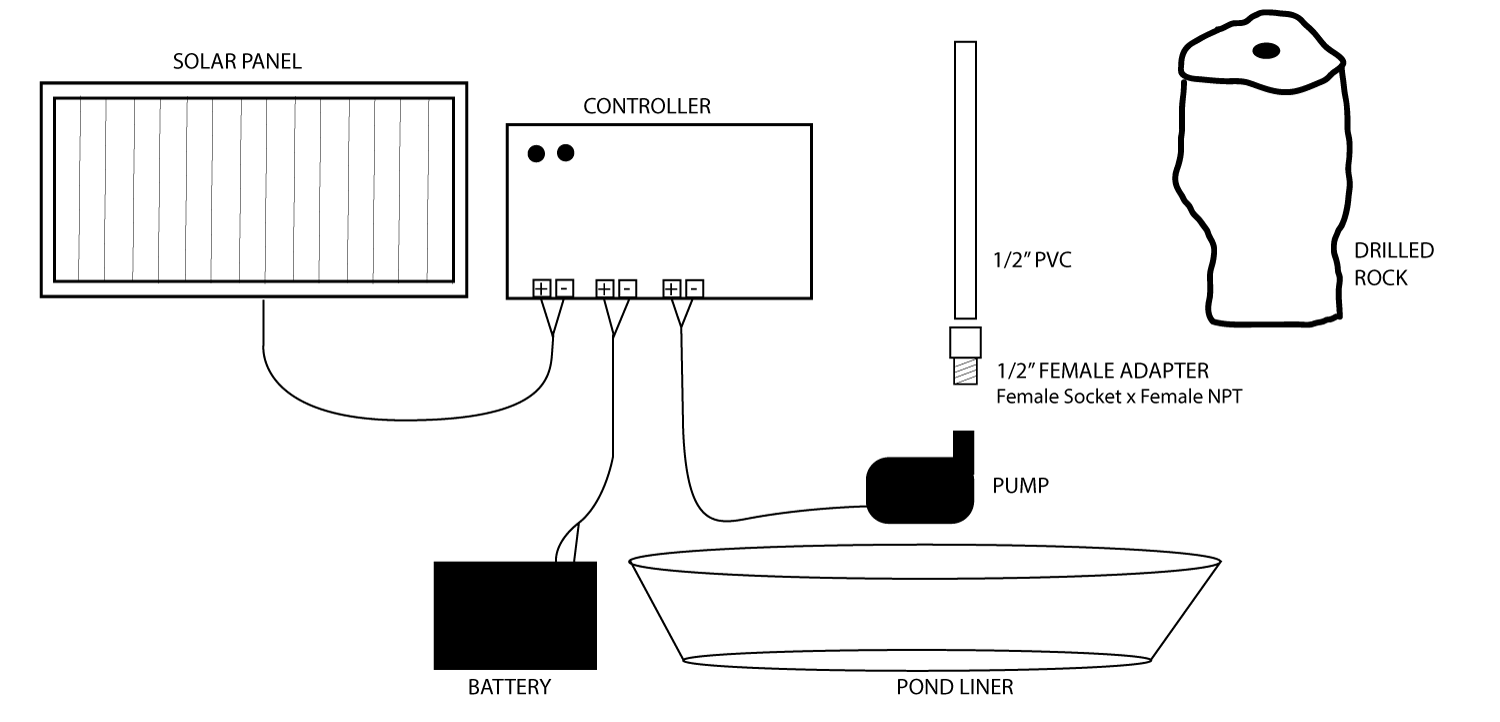
You don’t want to wire the panel directly to the battery, it turns out, because the electricity coming in is inconsistent; you want something called a controller in between them, which acts like a panel of sorts. Everything just connects to the controller, and it acts as the gateway between the panel, battery, and pump or whatever else you’ll connect.
I finally found a panel that came with its own controller, and separately, a battery and a 410GPH pump with six feet of rise. It was a DC pump, not an AC pump, which is important since the controller is also DC.
Using a small screwdriver and a pair of wire strippers, I first connected the panel to the controller, and then, with the panel turned over so it wasn’t receiving sunlight, connected the controller to the battery, to see if it would work. I always made sure my body was never completing the circuit, which means that I never touched the positive and the negative wires at the same time, and I wore gloves. This is super important so you don’t electrocute yourself. I turned over the panel, and the lights came on on the controller, indicating it worked.
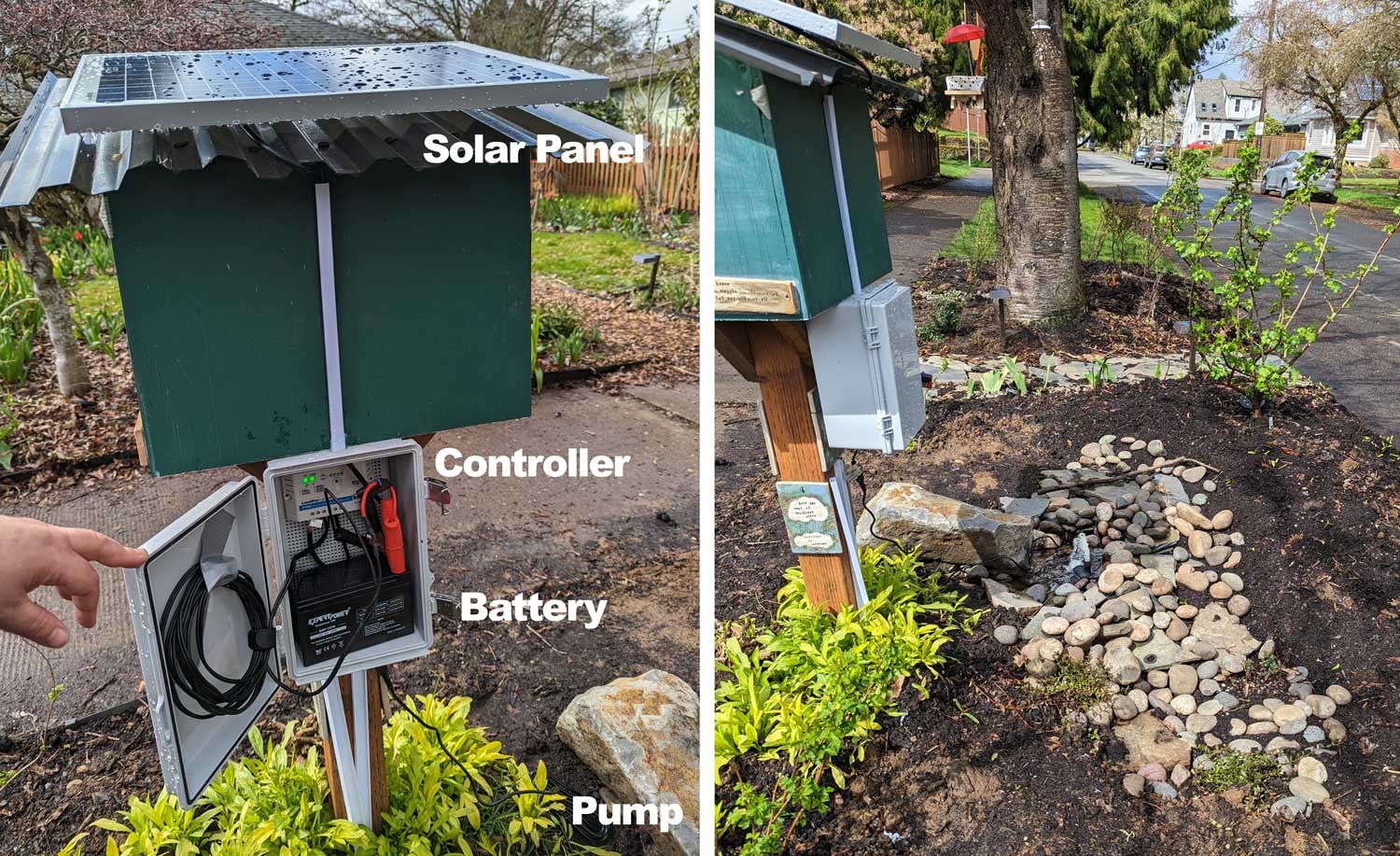
Next, I took the disconnected pump cord, cut off the prongs, stripped the wire, and then added the positive and negative to the controller. I put the pump itself into a bowl of water, and then connected it to the cord. Water shot into the air. It was surprisingly pleasing, and it cost me just $US150 ($208). I purchased a junction box to keep it all in, and neatly arranged it, locked it up, and buried a twelve-inch pond liner in the ground — though a five gallon bucket would have worked fine — added the pump, filled it with rocks, and then used a one-inch wide, two-foot long drill bit on a big rock a neighbour was giving away. I attached a ½-inch PVC pipe to the pump, threaded the rock onto it, and cut the pipe to the height of the rock.
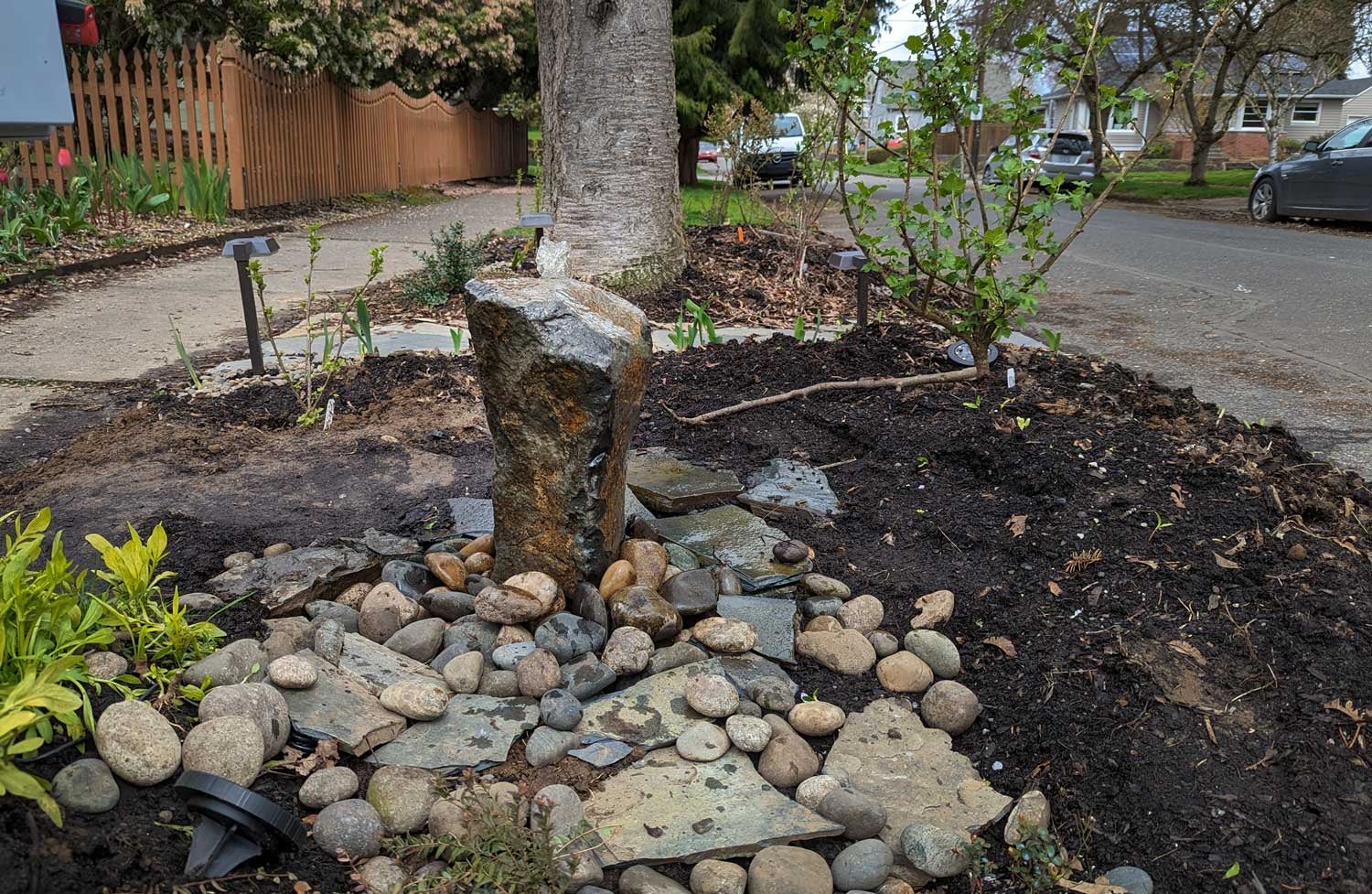
Now that you’ve learned how to command the power and the water to your will, you can create these solar relays anyplace you’d like to get some power into your yard for water pumps, lights, or whatever else you need.
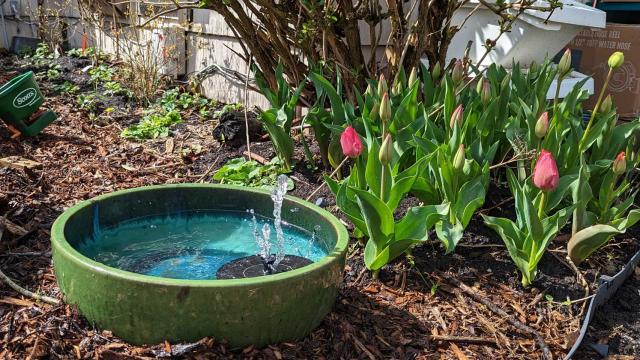
Leave a Reply
You must be logged in to post a comment.